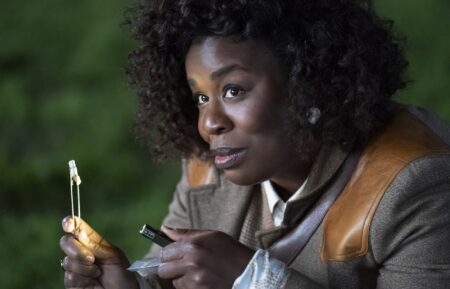‘Married… With Children’ at 30: Crude, Rude and Still Influential

Married… With Children debuted on April 5, 1987 to decidedly mixed reviews, with one critic hailing it as “a brisk antidote to the syrupy sentimentality that has lately taken over The Cosby Show” (the working title of Married was Not the Cosbys), while another slamming it as “loud, coarse and life-of-the-party vulgar.”
They were both right.
By time it went off the air in 1997—doomed less by its ratings decline than by salary and production demands—Married was among the longest-running sitcoms in television history, joining the likes of M*A*S*H, Cheers and Frasier. It remains successful in syndication (find it on TBS), and in many slavish international adaptations (Married With Children in Bulgaria is a real thing).
Trashy, racy, occasionally rancid, and completely and utterly unapologetic, Married was revolutionary, kicking over taboos and capsizing more than a decade of toothless family fare. Its influence can still be felt on TV today.
Married help shape Fox’s identity as risk-taker
Married was the very first primetime TV show to debut on Fox, which based its entire business model on envelope-pushing, thumbing its nose at the Big Three networks and embracing edgier fare that would attract the all-important 18-34 demographic.
When Married premiered, The Cosby Show, Family Ties and Growing Pains ruled the airwaves, and even the sitcoms built around more unconventional family units (Kate & Allie, Who’s the Boss?) hewed to the same safe, sterile and comfortable formula. Creators Michael G. Moye and Ron Leavitt (The Jeffersons) believed these comedies were ripe for parody.
Enter shoe salesman Al Bundy (Ed O’Neill), slumped on the couch, one hand forever tucked inside his waistband, and his shopaholic wife Peg (Katey Sagal), mincing in leopard print and heels with a cherry-red bouffant. They had a classic Ralph-and-Alice dynamic but here it was built almost entirely around her sexual frustration and his failure to perform.
Peggy: “Al, I need sex.”
Al: “Me too. But I don’t see a reason to drag you into it.”
Meanwhile, sexually frustrated son Bud’s (David Faustino) favorite activity is slut-shaming his trashy sister Kelly (Christina Applegate), despite the fact that the ability to feel shame is not a Bundy family trait.
Nothing was off-limits: masturbation, menstruation, STDs, vibrators, erections, bowel movements, light S&M (although one episode featuring a Bundy sex tape was deemed too racy to air and was only later broadcast in syndication). It aimed low, and we’re still searching for the bottom today.
Fox continued to bet on outside-the-box fare with great success—Cops, The Simpsons, In Living Color, The X-Files, Ally McBeal, Glee, to name a few—and it is still considered the broadcast network with the riskiest lineup.
Married returned the sitcom to its working class roots
Sure, Kate and Allie roomed together out of necessity following their respective divorces, and Tony became Angela’s housekeeper in Connecticut because he wanted to move his daughter out of their rough Brooklyn neighborhood, but few characters on network television were really hurting until the Bundys came along.
Would there be a Roseanne, which debuted on ABC 18 months later, without Married… With Children? (Fun fact: Roseanne Barr was first considered for the role Peg Bundy.) Maybe, but Married certainly reminded programmers that working-class comedies about families in flyover country struggling to make ends meet were still relatable to vast swaths of America. (And it’s a narrative that still has resonance, as many political observers were surprised to discover following the November presidential election.)
Family Matters, King of Queens, Malcolm in the Middle, and Still Standing followed, and the pendulum swings back and forth—Married star O’Neill is now playing a closets mogul with a much-improved sex life but some of the same retrogade Bundyisms on Modern Family — but you can spot Married’s DNA in current shows like ABC’s long-running The Middle, Fox’s new comedy The Mick and CBS’s Mom.
Married confirmed that bad publicity is good publicity

Promotional portrait of actors Ed O’Neill and Katey Sagal for the television series ‘Married with Children,’ 1993.
In 1989, a Michigan housewife named Terry Rakolta started petitioning Fox advertisers to pull out of the network because of the “consistently offensive” and “anti-family” Married: “I care that there are advertisers out there paying the freight for this. They’re taking my dollars and putting them into soft-core pornography.”
A few advertisers did leave the network, only to later return after the controversy led curious viewers to check out the show—and to keep tuning in. The spike in ratings even allowed Fox to charge more for ad time. (Fox did eventually move the show to the 9 p.m. time slot, out of what was known as “Family Viewing Time.”)
But the backfire would not stop conservative groups from targeting networks or their advertisers for shows they deemed unacceptable—from Ellen DeGeneres’ coming-out episode on Ellen to animated fare like South Park and Family Guy to pretty much anything Ryan Murphy produces (on FX, Fox’s cable cousin) to the police procedural from hell, Lucifer, which was recently renewed for a third season…on Fox.
One thing that never changed? Married itself. In the last episode ever produced, “How To Marry a Moron,” Kelly is set to wed her just-paroled boyfriend Lonnie (Nashville‘s Charles Esten) when the family realizes he’s a two-timer. Al stops the wedding and delivers this stirring paean to matrimony: “We Bundys may have our faults, but we believe that marriage should be forever—no matter how pitiful and disgusting it may be to wake up to that same horrifying face each day. That’s what the marriage vows are all about!”










